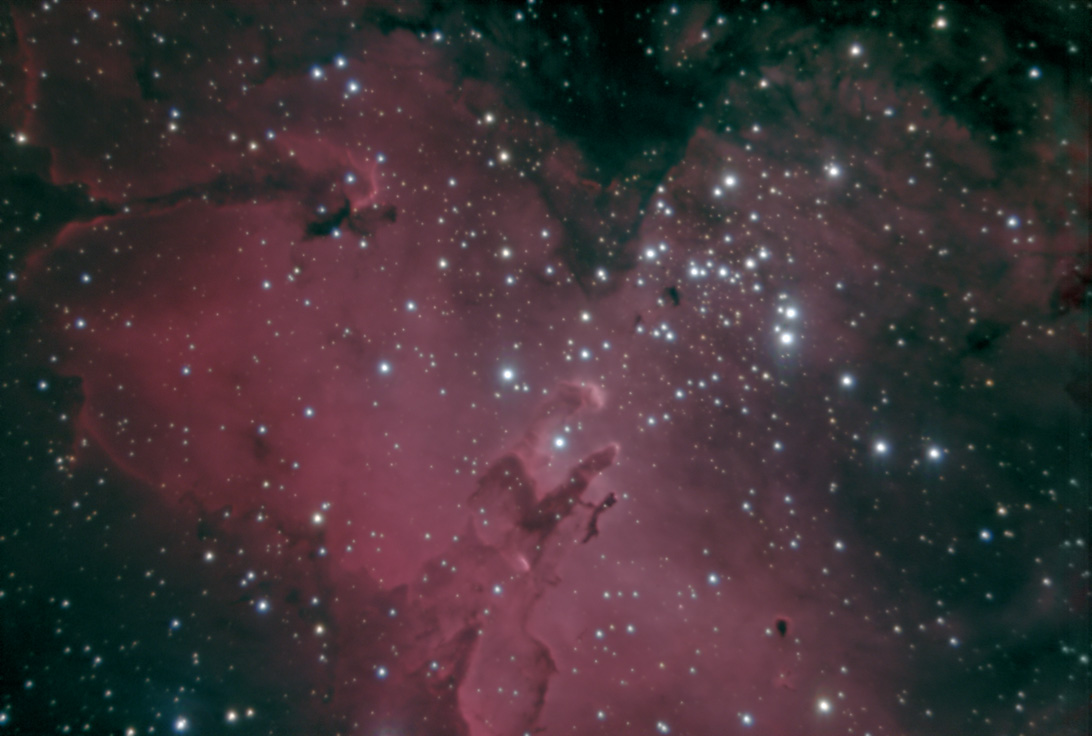M16 - Eagle Nebula (LHaRGB)

For high resolution, click here.
M16 - Eagle Nebula (LHaRGB): The Eagle Nebula, which includes the "Pillars of Creation" are imaged here in "natural" red-green-blue colors. In star forming regions, gravity pulls together clumps from the cloud of gas that collapse and form the stars. The first stars that form are the massive, bright blue stars near the center of the cluster. These emit lots of ultraviolet light that then excites the gas in the surrounding clouds. The intense radiation from these same stars is also "blowing away" the clouds - in direct competition with gravity. These competing forces give the "melting candle wax" appearance of parts of this nebula.
Messier: 16
NGC: 6611
Right Ascension: 18h 18.8m
Declination: -13° 47'
Apparent Magnitude: 6.4
Date: August 2010
Equipment:
Telescope: Meade 16" Schmidt Cassegrain
Camera: SBIG ST-10XE
Guiding: AO-8
Exposure: L: 60x30s
H-alpha 9x10m (35% overlay with L)
RGB: 10x3m
The camera was at -30°C or -35°C depending on the night
Processing Notes: Data acquisition with CCDSoft. Reduced and aligned in CCDStack. Subs combined in Sigma Beta. Arcsine stretch import of L and H-alpha into Photoshop. Adjusted curves and levels. Slight blur and noise reduction on the dim areas and sharpening on non-star bright areas. A highpass filter of the non-star regions was overlayed to increase contrast. Slight minimum filter on the brighter stars, and an extra minimum iteration on the stars near the edges. The H-alpha data was applied as a 35% overlay on the luminance. RGB channels were combined in AstroArt at a ratio of 1:1.05:1.8 to account for atmospheric extinction. Adjusted curves and levels, and reduced noise of RGB. L+H-alpha(35%) was combined with RGB using three layers: Luminance on the bottom; desaturated RGB as a multiply(40%) layer; and RGB as a color layer on top. Final stretch and tweak in Photoshop.
Scale: 0.53"/pixel on high resolution
Links to images of this object on other sites:
http://apod.nasa.gov/apod/ap080719.html
http://www.astrocruise.com/milky_way/M16_02.htm
http://www.narrowbandimaging.com/images/m16_mk1sn2_dm_geg_cs4_ha_12x10min_svga.jpg
Additional Comments: Numerous other Eagle Nebula images taken from the Fort Lewis Observatory, including individual color and narrow band channels can be found by searching this site for M16.
A note on the colors: To get an emission nebula, you need very hot stars that emit ultraviolet radiation. The ultraviolet photons are energetic enough to "excite" the electron in a hydrogen atom into a higher energy state. When these excited electrons decay from one of the many higher excited states into the first excited state, the photons emitted are part of the Balmer series. The lowest energy transition in this series is going from the second to the first excited state, in which case a red, H-alpha (656.3nm) photon is emitted. Going directly from the third excited state to the first excited state, the atom will emit an H-beta photon (486.1nm). The ratio of the red H-alpha and cyan H-beta give an emission nebula its' magneta color. Note that when an electron decays to the ground state, which is a much larger energy drop, an ultraviolet photon is emitted. For more information, see: http://en.wikipedia.org/wiki/Balmer_series
Views: 12134
 This work is licensed under a Creative Commons Attribution-NonCommercial-ShareAlike 4.0 International License.
This work is licensed under a Creative Commons Attribution-NonCommercial-ShareAlike 4.0 International License.

